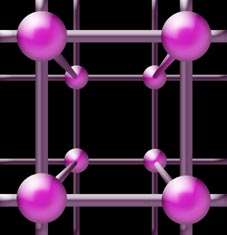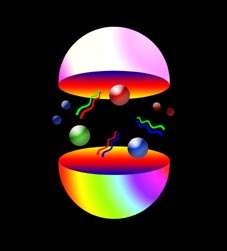Particle Physicists are embarking on a new attempt to solve the mysteries of quarks with the completion of the three most powerful supercomputers ever applied to this problem, including one at the University of Edinburgh for use by the UK Quantum Chromodynamics (UKQCD) collaboration of scientists from seven British Universities.
Quarks are the fundamental particles that make up 99.9% of ordinary matter; yet it is impossible to examine a single quark in the laboratory. Consequently, some of the basic properties of quarks are not known, such as their precise masses or why they exist in six different types.
Image: In lattice QCD space-time is approximated by a four-dimensional box of points, similar to a crystal lattice. Credit Ian McVicar
Quarks are bound together by the Strong Force, which is weak when the quarks are close, but increases steadily as you try to separate them, making it impossible to isolate a single quark. Instead, the theory describing the Strong Force, called Quantum Chromodynamics (QCD), has to be simulated on huge computers.
The Edinburgh computer is the first of three similar machines and has been operating since January 2005. The second computer is being inaugurated today at the RIKEN Brookhaven Research Center in Brookhaven National Laboratory in the USA. The third is part of the U.S. Department of Energy Program in High Energy and Nuclear Physics, and is also installed at Brookhaven where it is currently undergoing testing.
The computers are built with processing chips specifically designed for the purpose, known as QCD-on-a-chip, or QCDOC for short. A little slower than the microprocessor in your laptop, the QCDOC chip was designed to consume a tenth of the electrical power, so that tens of thousands of them could be put into a single machine. The computers were designed and built jointly by the University of Edinburgh, Columbia University (USA), the RIKEN Brookhaven Research Center (USA) and IBM.
Image: The proton consists of three quarks, two up and one down, living in a complicated soup of dynamical quarks, antiquarks and gluons, which have 'colour' charges. The total colour charge of the proton is zero. Lattice QCD enables us to calculate the mass of the proton and its internal structure. Credit Ian McVicar
Each QCDOC machine operates at a speed of 10 Teraflops, or 10 trillion (i.e. million million) floating point operations per second. By comparison, a regular desktop computer operates at a few Gigaflops (a thousand million floating point operations per second), whilst IBM's BlueGene, a close relative of QCDOC and the fastest computer in the world, operates at over 100 Teraflops. Edinburgh's machine and part of the QCDOC development costs were funded through a Joint Infrastructure Fund Award of £6.6million administered by PPARC. PPARC also fund the UK scientists in this field.
Prof Richard Kenway, who led UK participation in the QCDOC Project, said "After five years building this machine, it's exhilarating to be able to compute in days things which take everybody else months. Now we are about to run QCDOC for months to do the most realistic QCD simulation yet. It's like standing on the shore of a new continent after a long voyage, we've chosen our path of exploration, but we don't know what we're going to find."
PPARC's Chief Executive, Prof Richard Wade, welcomed the start of the QCDOC supercomputer saying "The UKQCD collaboration has been a world-leading group for some years, producing very elegant analysis methods to make the most of available computing resources. With the power of the new supercomputer at their fingertips, they will be able to make crucial advances to our understanding of fundamental particles like quarks."
The Mysteries of Quarks
-- Quarks never appear singly, but always as bound states of two or more, called hadrons, such as the protons and neutrons that make up the atomic nucleus. Thus, Nature hides its fundamental particles and we would like to understand better how the Strong Force achieves this.
-- Only the mass of the top quark is accurately known, because QCD effects are small for such a heavy particle. To determine the masses of the lighter quarks accurately (called up, down, strange, charm and bottom), QCD effects have to be computed. These masses are needed for detailed understanding of many phenomena and should eventually be predicted by the much sought after Theory of Everything.
-- There are six types of quark and this seems to be related to the small difference between matter and antimatter, called CP violation, that may help to explain why our Universe is dominated by matter (and hence why we can exist at all). QCD simulations are needed to discover whether our current theories can explain this, or there is some new physics at work.
-- The Theory of Everything is very likely to permit protons to decay. If so, the proton lifetime must be enormous, since no decay has yet been observed. Experimental lower bounds on the lifetime, together with QCD simulations, place restrictions on what the Theory of Everything can be and have already ruled out some candidates.
-- At enormously high temperatures and densities, such as may be found in neutron stars, everyday matter made of bound quarks may melt into a new type of matter. This change of phase, which is being searched for at Brookhaven National Laboratory by colliding gold and lead nuclei at high energies, is accessible to QCD simulations. What happens may tell us about what is going on inside some of the most exotic objects in the Universe.
The UKQCD Collaboration
UKQCD is a collaboration of particle physicists from the Universities of Edinburgh, Southampton, Swansea, Liverpool, Glasgow, Oxford and Cambridge. It was formed in 1989 and has exploited a series of novel architecture computers for QCD simulations, becoming one of the leading projects in this field world wide. QCDOC gives UKQCD for the first time the fastest computer in the world available for QCD simulations.
Source: PPARC

























